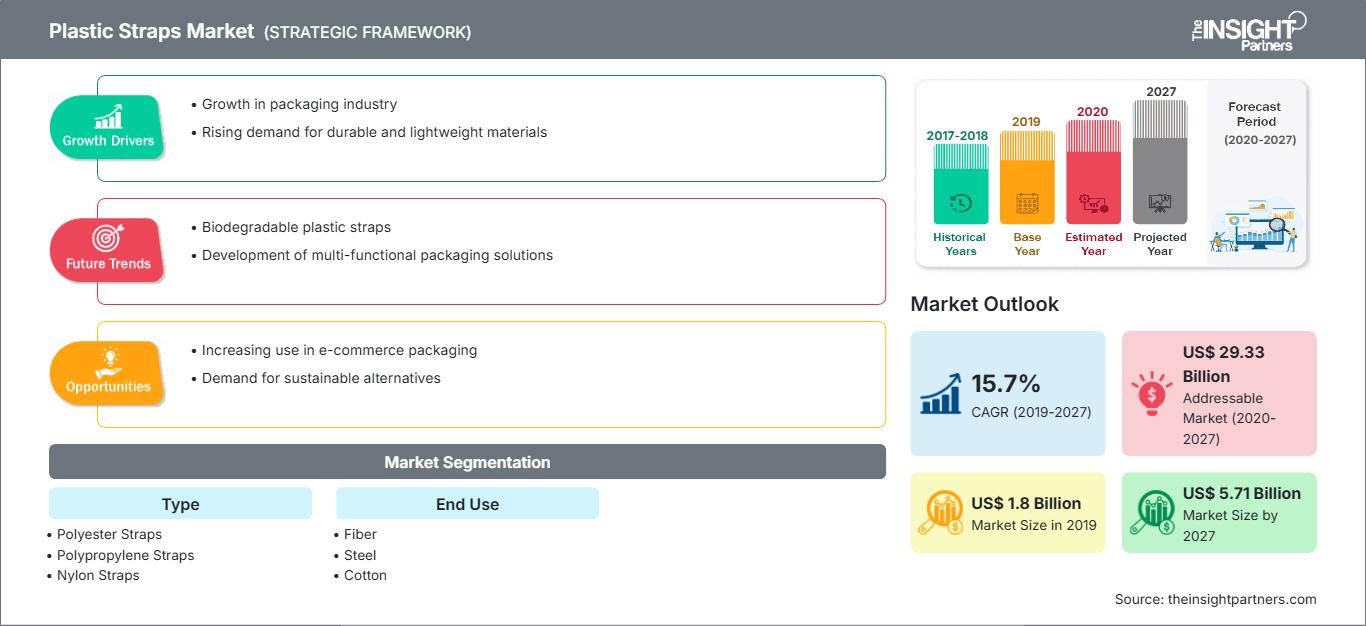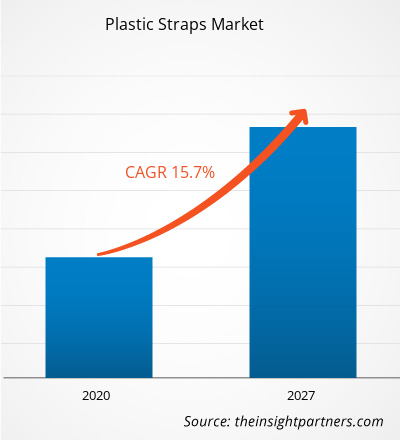[Informe de investigación] El mercado de correas de plástico se valoró en 1.802,47 millones de dólares estadounidenses en 2019 y se prevé que alcance los 5.714,12 millones de dólares estadounidenses en 2027; se espera que crezca a una tasa de crecimiento anual compuesta (TCAC) del 15,7% entre 2020 y 2027.
La demanda de flejes de plástico está creciendo debido al aumento en la demanda de mejores soluciones de embalaje y logística a nivel mundial. Además, el auge de las industrias del papel y la construcción ofrece oportunidades de crecimiento para el mercado de flejes de plástico. Asimismo, el crecimiento de este mercado se ve impulsado por el uso cada vez mayor de flejes de plástico en las industrias del papel, el acero y la fabricación de ladrillos y tejas. Los materiales para flejes de plástico se fabrican con polipropileno y poliéster, y están disponibles en una amplia variedad de estilos, resistencias y acabados.
América del Norte posee la mayor cuota de mercado global de flejes de plástico. Esta posición dominante se debe principalmente al aumento de la producción y el consumo de flejes de plástico en las economías desarrolladas y en desarrollo de la región. Estados Unidos se considera uno de los mercados más grandes, con una demanda y producción de flejes de plástico considerablemente altas. Otras economías que siguen la misma tendencia de crecimiento en este mercado son Canadá y México. El crecimiento de América del Norte se debe a factores como la rápida urbanización, la creciente preferencia por productos más avanzados en logística y embalaje, y el aumento de la renta disponible. Además, la presencia de importantes fabricantes en la región impulsa sustancialmente el crecimiento del mercado de flejes de plástico.
Estados Unidos, Brasil, India, Rusia, Sudáfrica, México, España y el Reino Unido se encuentran entre los países más afectados en cuanto a casos confirmados y fallecimientos reportados hasta agosto de 2020. La COVID-19 ha afectado las economías e industrias de diversos países debido a los confinamientos, las restricciones de viaje y el cierre de negocios. La industria química y de materiales global es una de las principales industrias que sufre graves interrupciones, como la ruptura de la cadena de suministro y la paralización de la producción, a causa del brote de COVID-19. Por ejemplo, China es el centro mundial de la manufactura y el mayor proveedor de materias primas para diversas industrias. El cierre de numerosas plantas y fábricas en China y en regiones clave como Asia Pacífico y Europa está afectando las cadenas de suministro globales e impactando negativamente la producción, los plazos de entrega y las ventas de diversos productos. Todos estos factores han afectado considerablemente el mercado global de flejes de plástico.
Obtendrá personalización gratuita de cualquier informe, incluyendo partes de este informe, análisis a nivel de país y paquetes de datos de Excel. Además, podrá aprovechar excelentes ofertas y descuentos para empresas emergentes y universidades.
Mercado de correas de plástico: Perspectivas estratégicas

-
Obtenga las principales tendencias clave del mercado que se describen en este informe.Esta muestra GRATUITA incluirá análisis de datos, que abarcarán desde tendencias de mercado hasta estimaciones y pronósticos.
Perspectivas del mercado
El desarrollo de plásticos de base biológica impulsa el crecimiento del mercado
El desarrollo de plásticos de base biológica es una de las principales tendencias en la industria global de flejes de plástico. La demanda de productos plásticos biodegradables crece rápidamente en aplicaciones industriales y de consumo, especialmente en el sector del embalaje. Los plásticos de base biológica, elaborados con materiales biodegradables, han ampliado aún más el alcance de los flejes de plástico en las industrias de bienes industriales y de consumo. La creciente demanda de gestión de residuos también ha impulsado la industria de los plásticos de base biológica. A medida que surgen materias primas sostenibles y de base biológica en los mercados emergentes, se espera que los plásticos de base biológica sean útiles en diversas aplicaciones nuevas en el futuro. Actualmente, algunas empresas están adoptando flejes de plástico ecológicos para ser más respetuosas con el medio ambiente y mejorar el proceso de embalaje. El fleje de PET se fabrica íntegramente a partir de botellas de PET, que se recolectan y se reciclan para transformarlas en nuevos productos.
Información sobre tipos
Según su tipo, el mercado de flejes de plástico se segmenta en flejes de poliéster, polipropileno, nailon, papel, compuestos y trenzados. El segmento de flejes de polipropileno representó la mayor cuota del mercado global en 2019; mientras que se espera que el segmento de flejes de poliéster experimente el mayor crecimiento anual compuesto (CAGR) durante el período de pronóstico. Los flejes de poliéster se han consolidado como una alternativa viable a los flejes de acero, ya que la corrosión de este último era un problema que se ha solucionado con la llegada de los flejes de poliéster. Anteriormente, se utilizaban flejes de acero para envolver los productos hasta la introducción de los flejes de poliéster en el mercado. Sin embargo, esto provocaba un deterioro en la calidad de los productos embalados con ellos, debido a la tendencia a la corrosión del acero. Esto tuvo un efecto perjudicial en la industria del transporte y otras industrias afines. Por ello, comenzó a surgir el mercado de soluciones de flejado alternativas, que además debían ser ligeras y resistentes. Como alternativa viable a los flejes de acero, esto ha impulsado el uso de flejes de poliéster. Los fabricantes han sabido aprovechar las ventajas de las cintas de poliéster, lo que ha generado una mayor demanda en el mercado. En Norteamérica, la demanda de cintas de poliéster es cada vez mayor, ya que representan una solución duradera y económica para la industria automotriz. Además, las cintas de poliéster son más baratas y rentables que otras opciones de flejado, especialmente las de acero.
Información sobre el uso final
Según su uso final, el mercado de flejes de plástico se segmenta en fibra, acero, algodón, papel y ladrillos y tejas. El segmento de papel representó la mayor cuota de mercado en 2019, mientras que se espera que el segmento de algodón registre la mayor tasa de crecimiento anual compuesto (CAGR) durante el período de pronóstico. El algodón es suave y no abrasivo, lo que permite un agarre firme en las hebillas. Gracias a las propiedades suaves y no abrasivas de la fibra de algodón, este material se sigue utilizando comúnmente en la confección de ropa y artículos para el hogar. Las cintas y correas de algodón también se utilizan en diversos sectores e industrias. Se emplean para la producción de correas, cinturones y amarres. Existe una creciente demanda de flejes de plástico para el embalaje de contenedores y cajas de balas de algodón, con el fin de brindar mayor seguridad al producto.
Las fusiones y adquisiciones, así como la investigación y el desarrollo, son estrategias comunes que las empresas adoptan para expandir su presencia global, lo que influye en el tamaño del mercado. Teufelberger Stralsund GmbH, Cyklop International, FROMM Group, Polychem Corporation y Crown Holdings, Inc. se encuentran entre los principales actores del mercado de flejes de plástico. Estas empresas ofrecen sus productos a nivel mundial, lo que les permite atender a una base de clientes más amplia. Estos actores clave del mercado están altamente enfocados en el desarrollo de productos innovadores y de alta calidad para satisfacer las necesidades de sus clientes.
Reportajes destacados
- Tendencias progresivas de la industria en el mercado global de flejes de plástico que ayudan a los participantes a desarrollar estrategias efectivas a largo plazo.
- Estrategias de crecimiento empresarial adoptadas por los mercados desarrollados y en desarrollo
- Análisis cuantitativo del mercado de flejes de plástico de 2017 a 2027
- Estimación de la demanda mundial de flejes de plástico en diversos sectores
- Análisis PEST para ilustrar la eficacia de compradores y proveedores que operan en la industria para predecir el crecimiento del mercado
- Últimos avances para comprender el panorama competitivo del mercado y la demanda mundial de flejes de plástico
- Tendencias y perspectivas del mercado, y factores que impulsan y restringen el crecimiento del mercado
- Comprensión de las estrategias que sustentan el interés comercial con respecto al crecimiento del mercado mundial de flejes de plástico, lo que facilita un proceso de toma de decisiones eficaz.
- Tamaño del mercado de correas de plástico en varios nodos del mercado
- Descripción general detallada y segmentación del mercado, así como la dinámica del sector.
- Tamaño del mercado mundial de flejes de plástico en diversas regiones con prometedoras oportunidades de crecimiento en estas regiones
Perspectivas regionales del mercado de correas de plástico
Los analistas de The Insight Partners han explicado en detalle las tendencias regionales y los factores que influyen en el mercado de flejes de plástico durante el período de previsión. Esta sección también analiza los segmentos del mercado de flejes de plástico y su distribución geográfica en Norteamérica, Europa, Asia Pacífico, Oriente Medio y África, y Sudamérica y Centroamérica.
Alcance del informe de mercado de correas de plástico
| Atributo del informe | Detalles |
|---|---|
| Tamaño del mercado en 2019 | 1.800 millones de dólares estadounidenses |
| Tamaño del mercado para 2027 | 5.710 millones de dólares estadounidenses |
| Tasa de crecimiento anual compuesto global (2019 - 2027) | 15,7% |
| Datos históricos | 2017-2018 |
| período de previsión | 2020-2027 |
| Segmentos cubiertos |
Por tipo
|
| Regiones y países cubiertos |
América del norte
|
| Líderes del mercado y perfiles de empresas clave |
|
Densidad de los participantes en el mercado de flejes de plástico: comprensión de su impacto en la dinámica empresarial
El mercado de flejes de plástico está creciendo rápidamente, impulsado por la creciente demanda de los usuarios finales debido a factores como la evolución de las preferencias de los consumidores, los avances tecnológicos y una mayor conciencia de los beneficios del producto. A medida que aumenta la demanda, las empresas amplían su oferta, innovan para satisfacer las necesidades de los consumidores y aprovechan las nuevas tendencias, lo que impulsa aún más el crecimiento del mercado.

- Obtenga una visión general de los principales actores del mercado de correas de plástico.
Mercado de correas de plástico, por tipo
- Correas de poliéster
- Correas de polipropileno
- Correas de nailon
- Correas de papel
- Correas compuestas
- Correas de cordón y tejido
Mercado de correas de plástico, por uso final
- Fibra
- Acero
- Algodón
- Papel
- Ladrillos y tejas
- Otros
Perfiles de empresas
- Teufelberger Stralsund GmbH
- Cyklop Internacional
- Grupo FROMM
- Correa automática India
- CONSENT LLC
- DuBose Strapping, Inc.
- LINDER GmbH
- Productos de flejado PAC, Inc.
- Crown Holdings, Inc.
- Corporación Polychem
- Análisis histórico (2 años), año base, pronóstico (7 años) con CAGR
- Análisis PEST y FODA
- Tamaño del mercado, valor/volumen: global, regional y nacional
- Industria y panorama competitivo
- Conjunto de datos de Excel
Informes recientes
Informes relacionados
Testimonios
Razón para comprar
- Toma de decisiones informada
- Comprensión de la dinámica del mercado
- Análisis competitivo
- Información sobre clientes
- Pronósticos del mercado
- Mitigación de riesgos
- Planificación estratégica
- Justificación de la inversión
- Identificación de mercados emergentes
- Mejora de las estrategias de marketing
- Impulso de la eficiencia operativa
- Alineación con las tendencias regulatorias






















 Obtenga una muestra gratuita para - Mercado de correas de plástico
Obtenga una muestra gratuita para - Mercado de correas de plástico